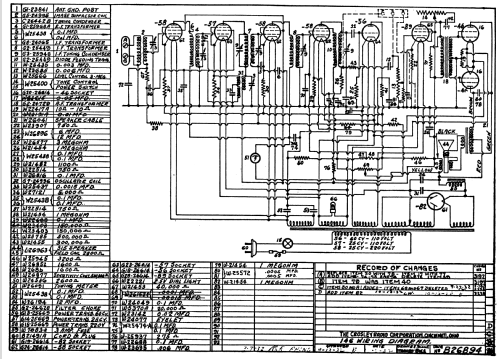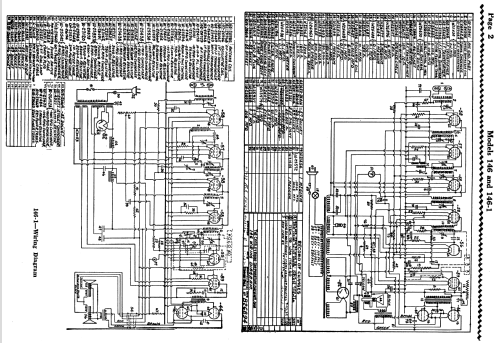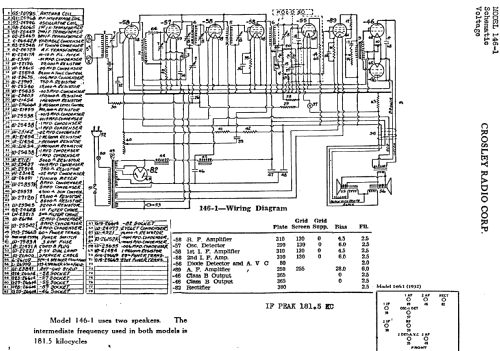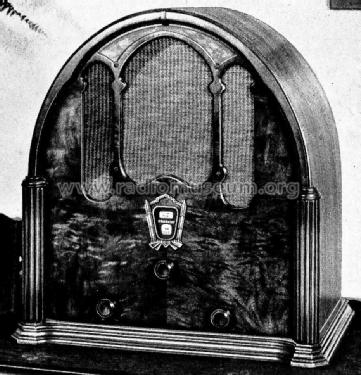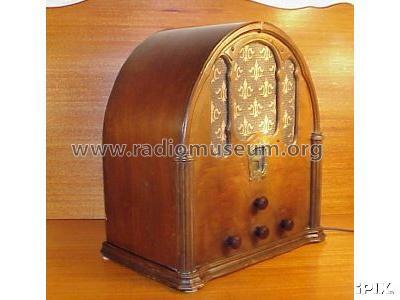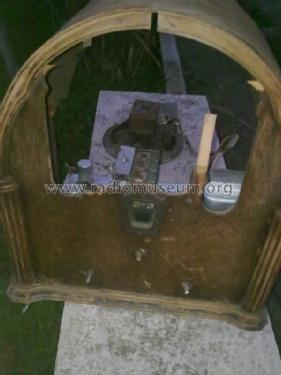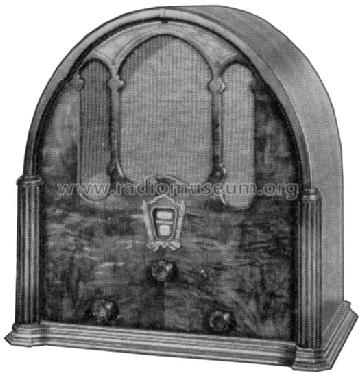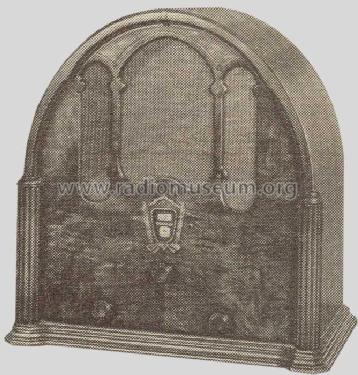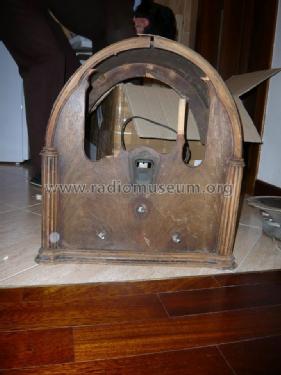146 "Mayor" Ch= 146
Crosley Radio Corp.; Cincinnati (OH)
- País
- Estados Unidos
- Fabricante / Marca
- Crosley Radio Corp.; Cincinnati (OH)
- Año
- 1932/1933

- Categoría
- Radio - o Sintonizador pasado WW2
- Radiomuseum.org ID
- 36238
Haga clic en la miniatura esquemática para solicitarlo como documento gratuito.
- Numero de valvulas
- 9
- Principio principal
- Superheterodino con paso previo de RF; ZF/IF 181.5 kHz; 2 Etapas de AF
- Número de circuitos sintonía
- 7 Circuíto(s) AM
- Gama de ondas
- OM (onda media) solamente
- Tensión de funcionamiento
- Red: Corriente alterna (CA, Inglés = AC) / 60 cycles, 110V or 25 cycles, 110V or 25 cycles, 220 Volt
- Altavoz
- Altavoz electrodinámico (bobina de campo) / Ø 8 inch = 20.3 cm
- Material
- Madera
- de Radiomuseum.org
- Modelo: 146 "Mayor" Ch= 146 - Crosley Radio Corp.;
- Forma
- Sobremesa tipo Capilla (upright, round top or pinted arch, not rounded edges only).
- Ancho, altura, profundidad
- 16.75 x 17.5 x 9.75 inch / 425 x 445 x 248 mm
- Anotaciones
-
The Crosley 146 "Mayor" is an AC operated 9 tube BC band receiver. Has RF gain stage, two stage IF amplifier, active AVC circuit with sensitivity control and push pull audio output stage. BC band tuning range is 550 to 1750kHz. Crosley advertised that the Police Band could be received due to this extended BC Band range.
Please note that some illustrations of this model show 3 knobs on the front panel, while others show 4 knobs. Actual radio models also appear to have 3 or 4 knobs on the front panel. Per the Crosley documentation, the knobs are as follows: volume, tuning, selectivity and tone/power switch. Thus for the 3 knob version, it is unclear where the selectivity control is located.
From the 1932-33 Crosley News Brochure: The front panel of this radio marvel is finished in beautiful stump walnut veneer. The delightfully reeded pillars support the Gothic arch at the top. Variety of decoration is furnished by an overlay of burl maple above the speaker grill. The nine tube superheterodyne chassis employs the new 2 1/2-volt heater type tubes.
In many cases Crosley used the chassis number as the model number, and added a model name to some models to help distinguish versions that used common chassis. The 146 and 146-1 chassis are similar except that the 146 chassis drives a single speaker while the 146-1 chassis drives two speakers. Here are the models that used the 146 and 146-1 chassis versions:
Model Model Type Chassis Speakers 146 "Senator" Console 146 Qty(1) 146 "Mayor" Table Top 146 Qty(1) 146-1 "Congressman" Table Top 146-1 Qty(2) Quote from Dave McClellan: "The Crosley 146 from about 1932 is a 9-tube superhet with a tuned RF amplifier and two IF amplifier stages. It receives only the broadcast band - the figures are 55 - 150 on the scale. The chassis is very complex and features a sophisticated AVC system with sensitivity control, push-pull class B output stage, a tuning meter, choke input filter power supply with mercury vapor rectifier, and both 2.5 and 6.3 volt filament tubes!" We can add that the broadcast band is extended (compared to chassis 124) and received the police band also.
There are 3 models associated with the 146 and 146-1 chassis that are not identified in the Crosley documentation, identified in this LINK.
- Precio durante el primer año
- 52.50 $ !
- Ext. procedencia de los datos
- Ernst Erb
- Procedencia de los datos
- Radio Collector`s Guide 1921-1932
- Mencionado en
- Table Top Radios Vol. 4 Stein 2003 (page 73.)
- Documentación / Esquemas (1)
- - - Manufacturers Literature (The Crosley Service Bulletin No. 42 Dated Dec. 1, 1932)
- Documentación / Esquemas (2)
- Crosley Radio Service Manual (Crosley Radio Service Manual 1943 and Earlier, Page 191)
- Documentación / Esquemas (3)
- Rider's Perpetual, Volume 3 = 1933 and before (Riders (Crosley) 3-23)
- Documentación / Esquemas (4)
- Cathedral & Tombstone Radios (page 89.)
- Otros modelos
-
Donde encontrará 1812 modelos, 1050 con imágenes y 1306 con esquemas.
Ir al listado general de Crosley Radio Corp.; Cincinnati (OH)
Colecciones
El modelo 146 "Mayor" es parte de las colecciones de los siguientes miembros.
Contribuciones en el Foro acerca de este modelo: Crosley Radio Corp.;: 146 "Mayor" Ch= 146
Hilos: 1 | Mensajes: 1
Crosley sold different models with the monoband chasssis 124. The year after they sold modesl with the chassis 146 (one loudspeaker for table top models) and with chassis 146-1 for consoles with two loudspeakers. Reading advertisements one might believe that this new chassis would have two bands, croadcast and police. In reality it is also a monoband chassis - which went up to quite a bit higher frequencies than the chassis 124.
That made some owners of models with the chassis 124 to later build in the 146 chassis which seems to be having the same size and knob positions. As an example, see the case of this model, an Announcer cabinet which normally has a 124 chassis - with a 146 chassis.
I asked Dave McClellan who owns also a special model with a chassis 146 to investigate how far it can tune the broadcast band. Here his answer:
I measured the highest frequency the Crosley 146 would receive. It was
1642kHz on my receiver. After that, dead quiet, as if the receiver was no
longer oscillating. The dial setting was 16 + about 4 ticks at this point.
Perhaps the type 57 converter tube could not handle any higher frequencies.
Maybe a different or a new tube could do better (the tube tested good). Or
perhaps the coils have absorbed moisture. And none of the mica capacitors
were changed in the restoration. So unfortunately, it is not possible to
determine the highest frequency the radio can receive, at least with MY
radio.
Thank you, Dave.
Ernst Erb, 19.Oct.11
